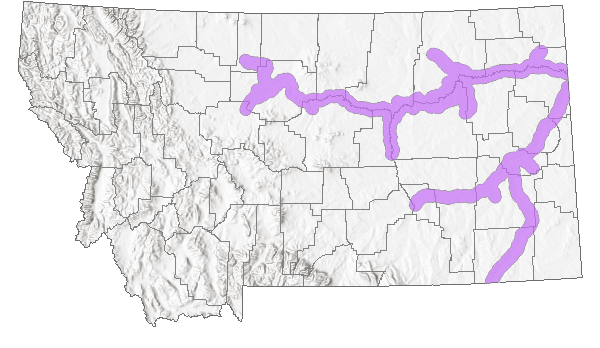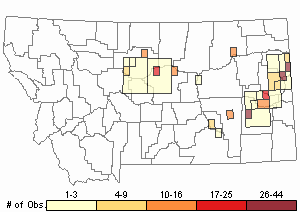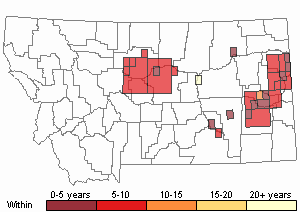View in other NatureServe Network Field Guides
NatureServe
Montana
Utah
Wyoming
Idaho
Wisconsin
British Columbia
South Carolina
Yukon
California
New York
Blue Sucker - Cycleptus elongatus
State Rank Reason (see State Rank above)
Species is distributed within river systems in eastern Montana. Although adult populations appear stable, breeding appears to be impacted by hydrologic changes to occupied systems which may lead to significant declines in population.
General Description
Eastern Montana is the home of the Blue Sucker. This species appears to inhabit only the larger streams, primarily the Missouri and Yellowstone rivers. It is easily recognized by its elongate shape, long dorsal fin, and slate-blue coloration. The largest weight for this species in Montana is slightly over 10 pounds. It was once taken commercially from the Mississippi River but is now too rare.
Montana populations appear to be stable and fairly abundant with a healthy size structure. Although the Blue Sucker populations appear to be healthy and stable, special recognition is warranted because this species may be susceptible to population declines due to its unique biological characteristics (longevity, low recruitment, migratory nature and reliance on high flows in tributary streams for spawning). Montana has some of the finest habitat for Blue Suckers found in their range and losses of Montana populations would be significant to the overall gene pool (
Montana AFS Species Status Account).
For a comprehensive review of the ecology, conservation status, threats, and management of this and other Montana fish species of concern, please see
Montana Chapter of the American Fisheries Society Species of Concern Status Reviews.Diagnostic Characteristics
The Blue Sucker has a back and sides that are dark blue to dark olive, and a white underside. Its most distinctive features are its elongated head/snout and the tall, sickle-shaped dorsal fin.
Species Range
Montana Range
Range Descriptions

 Native
Native
Western Hemisphere Range

Range Comments
The blue sucker has a widespread distribution extending throughout the Mississippi, Missouri, Ohio, and portions of the Rio Grande river systems (Elstad and Werdon 1993). In Montana, it is found in the Missouri as far upriver as Morony Dam near Great Falls, and in the Yellowstone upriver of Forsyth, MT.
Observations in Montana Natural Heritage Program Database
Number of Observations: 292
(Click on the following maps and charts to see full sized version)
Map Help and Descriptions
Relative Density

Recency



 (Observations spanning multiple months or years are excluded from time charts)
(Observations spanning multiple months or years are excluded from time charts)
Migration
Blue Suckers make long spawning movements from the lower Missouri River to upstream areas and tributary streams. Dispersal downstream follows.
Habitat
Blue Suckers prefer waters with low turbidity and swift current (Brown 1971).
Food Habits
The species feeds mainly on aquatic insects (Brown 1971).
Ecology
The Blue Sucker is adapted for life in swift currents. This fish prefers swift current areas of large rivers, feeding on insects in cobble areas (Moss et al. 1983). In the spring Blue Suckers migrate upriver and congregate in fast, rocky areas to spawn. Large numbers have been observed migrating up tributary streams to spawn. The Tongue, Marias, Milk and Teton rivers are the tributary streams most heavily used. Blue Suckers can live longer than 17 years. Blue Suckers sampled in Montana are typically older and larger fish, with lengths of 60 to 75 centimeters and weights of 3 to 5 kilograms. Berg (1981) reported that 93% of sampled fish in the upper Missouri were 9 to 14 years old. The Blue Sucker is monogenetic and is not known to hybridize with any other species (
Montana AFS Species Status Account).
Reproductive Characteristics
Reproductive success may be a problem for this habitat-specific species. Very few young-of-the-year Blue Suckers have been collected while sampling with a variety of methods. Moreover, the populations are dominated by older fish, indicative of minimal recruitment. Blue Sucker larvae have been collected from the Milk River, Big Muddy Creek, and in the lower Missouri and Yellowstone rivers (Gardner and Stewart 1987, Penkal 1981). Additionally, young-of-the-year Blue Suckers have been sampled at the Milk River confluence and in Big Muddy Creek of the lower Missouri River (Liebelt 1996, Stewart 1980,
Montana AFS Species Status Account).
Blue Suckers are probably sexually mature at 2 to 3 years. They spawn in April to June at temperatures of 50 degrees F. (Brown 1971).
Management
Management of the Blue Sucker consists mainly of routine monitoring of population status and habitat protection. The Blue Sucker is considered an indicator species for ecosystem health because of its habitat-specific requirements. Current monitoring information indicates the populations are in stable condition. Efforts towards locating spawning and rearing areas should be continued. Habitat protection includes protecting or promoting the natural spring-time hydrograph. Establishment of more natural seasonal flow conditions are presently being discussed and initiated for three storage reservoirs in Montana (
Montana AFS Species Status Account).
Stewardship Responsibility
Threats or Limiting Factors
Like all big river fish, riverine losses have occurred due to impoundments, where there have been major population losses and blue sucker populations have been fragmented. In Montana, the blue sucker is present in most places that have available habitat. The lower Yellowstone River blue sucker population would probably exist farther upriver if the Cartersville Diversion Dam and other diversion dams on the Yellowstone did not restrict upriver passage.
References
- Literature Cited AboveLegend:
 View Online Publication
View Online Publication Berg, R.K. 1981. Fish populations of the wild and scenic Missouri River, Montana. Montana Department of Fish, Wildlife and Parks. 242 p.
Berg, R.K. 1981. Fish populations of the wild and scenic Missouri River, Montana. Montana Department of Fish, Wildlife and Parks. 242 p. Gardner, W. M. and P. A. Stewart. 1987. The fishery of the Lower Missouri River, Montana. Montana Department of Fish, Wildlife and Parks, Restoration Project FW-2-R. 224 p.
Gardner, W. M. and P. A. Stewart. 1987. The fishery of the Lower Missouri River, Montana. Montana Department of Fish, Wildlife and Parks, Restoration Project FW-2-R. 224 p. Lee, D.S., C.R. Gilbert, C.H. Hocutt, R.E. Jenkins, D. E. McAllister, J. R. Stauffer, Jr. 1980. Atlas of North American freshwater fishes. North Carolina State Musuem of Natural History. 867 p.
Lee, D.S., C.R. Gilbert, C.H. Hocutt, R.E. Jenkins, D. E. McAllister, J. R. Stauffer, Jr. 1980. Atlas of North American freshwater fishes. North Carolina State Musuem of Natural History. 867 p. Liebelt, J. E. 1996. Lower Missouri River and Yellowstone River pallid sturgeon study. Montana Department of Fish, Wildlife and Parks Report Number 5-FG-60-06290. 57 p.
Liebelt, J. E. 1996. Lower Missouri River and Yellowstone River pallid sturgeon study. Montana Department of Fish, Wildlife and Parks Report Number 5-FG-60-06290. 57 p. Montana Chapter of the American Fisheries Society species status accounts.
Montana Chapter of the American Fisheries Society species status accounts. Moss, R. E., J. W. Scanlan, and C. S. Anderson. 1983. Observations on the natural history of the blue sucker (Cycleptus elongatus Le Sueur) in the Neosho River. American Midland Naturalist 109:15-22.
Moss, R. E., J. W. Scanlan, and C. S. Anderson. 1983. Observations on the natural history of the blue sucker (Cycleptus elongatus Le Sueur) in the Neosho River. American Midland Naturalist 109:15-22. Penkal, R.F. 1981. Life history and flow requirements of paddlefish, shovelnose sturgeon, channel catfish, and other fish in the lower Yellowstone River system. Montana Department of Fish, Wildlife, and Parks. 53 p.
Penkal, R.F. 1981. Life history and flow requirements of paddlefish, shovelnose sturgeon, channel catfish, and other fish in the lower Yellowstone River system. Montana Department of Fish, Wildlife, and Parks. 53 p. Scott, W.B. and E.J. Crossman. 1973. Rainbow trout, Kamloops trout, Steelhead trout Salmo gairdneri Richardson. pp. 184-191. In: Freshwater fishes of Canada. Ottawa, Canada: Fisheries Research Board of Canada, Bulletin 184. 966 p.
Scott, W.B. and E.J. Crossman. 1973. Rainbow trout, Kamloops trout, Steelhead trout Salmo gairdneri Richardson. pp. 184-191. In: Freshwater fishes of Canada. Ottawa, Canada: Fisheries Research Board of Canada, Bulletin 184. 966 p. Stewart, P. 1980. Lower Missouri River Basin investigations: planning inventory, fisheries. Montana Department of Fish, Wildlife and Parks.
Stewart, P. 1980. Lower Missouri River Basin investigations: planning inventory, fisheries. Montana Department of Fish, Wildlife and Parks.
- Additional ReferencesLegend:
 View Online Publication
View Online Publication
Do you know of a citation we're missing? Albers, Mark., 1995, Draft Biological Assessment: Tongue River Basin Project. May 1995. In Tongue River Basin Project Draft Environmental Impact Statement. Appendix B. June 1995.
Albers, Mark., 1995, Draft Biological Assessment: Tongue River Basin Project. May 1995. In Tongue River Basin Project Draft Environmental Impact Statement. Appendix B. June 1995. Alvord, W., Newman, L.H. Carufel, C.J.D. Brown, Elser and Peterman. 1954-1974. MSU Reference Catalogue - Blue Sucker.
Alvord, W., Newman, L.H. Carufel, C.J.D. Brown, Elser and Peterman. 1954-1974. MSU Reference Catalogue - Blue Sucker. Brown, C.J.D. 1971. Fishes of Montana. Bozeman, MT: Big Sky Books/Montana State University. 207 p.
Brown, C.J.D. 1971. Fishes of Montana. Bozeman, MT: Big Sky Books/Montana State University. 207 p. Duncan, M.B. 2019. Distributions, abundances, and movements of small, nongame fishes in a large Great Plains river network. Ph.D. Dissertation. Bozeman, MT: Montana State University. 255 p.
Duncan, M.B. 2019. Distributions, abundances, and movements of small, nongame fishes in a large Great Plains river network. Ph.D. Dissertation. Bozeman, MT: Montana State University. 255 p. Gardner, W.M. 1999. Population status of the blue sucker in Montana.4 p. In: Tews, A., B. Gardner and B. Gardner. Status of Native Fishes of 'Special Concern' in Montana. Unpublished Report on 16 Species. Incomplete - in Progress.
Gardner, W.M. 1999. Population status of the blue sucker in Montana.4 p. In: Tews, A., B. Gardner and B. Gardner. Status of Native Fishes of 'Special Concern' in Montana. Unpublished Report on 16 Species. Incomplete - in Progress. Joslin, Gayle, and Heidi B. Youmans. 1999. Effects of recreation on Rocky Mountain wildlife: a review for Montana. [Montana]: Montana Chapter of the Wildlife Society.
Joslin, Gayle, and Heidi B. Youmans. 1999. Effects of recreation on Rocky Mountain wildlife: a review for Montana. [Montana]: Montana Chapter of the Wildlife Society. Montana Department of Fish, Wildlife and Parks. 1989. Northeast Montana Warmwater Ecosystem Investigations: project period 7/1/88 through 6/30/89. Proj.# F-46-R-2; Job# V-e. 21p.
Montana Department of Fish, Wildlife and Parks. 1989. Northeast Montana Warmwater Ecosystem Investigations: project period 7/1/88 through 6/30/89. Proj.# F-46-R-2; Job# V-e. 21p. Mullins, M.S. 1991. Biology and predator use of cisco (Coregonus artedi) in Fort Peck Reservoir, Montana. M.Sc. Thesis. Bozeman, MT: Montana State University. 68 p.
Mullins, M.S. 1991. Biology and predator use of cisco (Coregonus artedi) in Fort Peck Reservoir, Montana. M.Sc. Thesis. Bozeman, MT: Montana State University. 68 p. Stash, S.W. 2001. Distribution, relative abundance, and habitat associations of Milk River fishes related to irrigation diversion dams. M.Sc. Thesis. Bozeman, MT: Montana State University. 82 p.
Stash, S.W. 2001. Distribution, relative abundance, and habitat associations of Milk River fishes related to irrigation diversion dams. M.Sc. Thesis. Bozeman, MT: Montana State University. 82 p. Trenka, R.J. 2000. Community structure and habitat associations of fishes of the lower Tongue and Powder Rivers. M.Sc. Thesis. Bozeman, MT: Montana State University. 85 p.
Trenka, R.J. 2000. Community structure and habitat associations of fishes of the lower Tongue and Powder Rivers. M.Sc. Thesis. Bozeman, MT: Montana State University. 85 p. USDI Bureau of Land Management. No date. Fishes of the Miles city, Montana BLM District. Miles City, MT: Miles City BLM District pamphlet. 12 p.
USDI Bureau of Land Management. No date. Fishes of the Miles city, Montana BLM District. Miles City, MT: Miles City BLM District pamphlet. 12 p. Williams, J.E., J.E. Johnson, D.A. Hendrickson, S. Contreras-Balderas, J.D. Williams, M. Navarro-Mendoza, D.E. McAllister, and J.E. Deacon. 1989. Fishes of North America endangered, threatened, or of special concern: 1989. Fisheries 14(6):2-20.
Williams, J.E., J.E. Johnson, D.A. Hendrickson, S. Contreras-Balderas, J.D. Williams, M. Navarro-Mendoza, D.E. McAllister, and J.E. Deacon. 1989. Fishes of North America endangered, threatened, or of special concern: 1989. Fisheries 14(6):2-20. Young, B.A., T.L. Welker, M.L. Wildhaber, C.R. Berry, and D. Scarnecchia (eds). 1997. Population structure and habitat use of benthic fishes along the Missouri and Lower Yellowstone Rivers. 1997 Annual report of Missouri River Benthic Fish Study PD-95-5832 to U.S. Army Corps of Engineers and U.S. Bureau of Reclamation. 207 p.
Young, B.A., T.L. Welker, M.L. Wildhaber, C.R. Berry, and D. Scarnecchia (eds). 1997. Population structure and habitat use of benthic fishes along the Missouri and Lower Yellowstone Rivers. 1997 Annual report of Missouri River Benthic Fish Study PD-95-5832 to U.S. Army Corps of Engineers and U.S. Bureau of Reclamation. 207 p.
- Web Search Engines for Articles on "Blue Sucker"
- Additional Sources of Information Related to "Fish"





